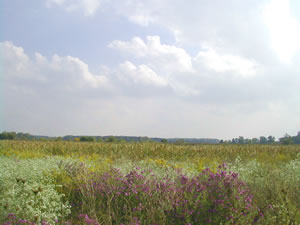


Stop 2: Pothole Wetland
A disappearing resource

The pothole wetland located on the Loblolly Marsh Wetland Preserve is a rare example of what used to be quite common across Indiana and other midwestern states. Some people estimate that between 60 and 98 percent of wetlands that were here in 1850 have now been destroyed. Most of these destroyed wetlands were pothole wetlands.
Erosion became a problem for the land surrounding the destroyed wetlands. As farming increased, layers of minerals in the soil began to collect in places like the Loblolly Marsh. A thick layer of soil rich in minerals now rests on top of the traditional organic top layer.
 Pothole
wetlands formed thousands of years ago, when the glaciers that covered
the northern two-thirds of Indiana began to melt. Depressions were formed
in the ground because of the intense weight of these glaciers and buried
ice blocks. The melting
of the glaciers exposed the depressions and also filled them with water.
Pothole
wetlands formed thousands of years ago, when the glaciers that covered
the northern two-thirds of Indiana began to melt. Depressions were formed
in the ground because of the intense weight of these glaciers and buried
ice blocks. The melting
of the glaciers exposed the depressions and also filled them with water.
Why shouldn't we destroy wetlands?
- They prevent floods by storing water
- They absorb silt and nutrients that would otherwise pollute rivers and streams
- They provide habitat for many different species of plants and animals
Links:
Prairie
Potholes
Source:
Kluess, Steven K. Soil Survey of Blackford and Jay Counties, Indiana. Washington, DC: USDA, 1986.
The Loblolly Virtual Nature Trail was created as a part of the Our Land, Our Literature website.